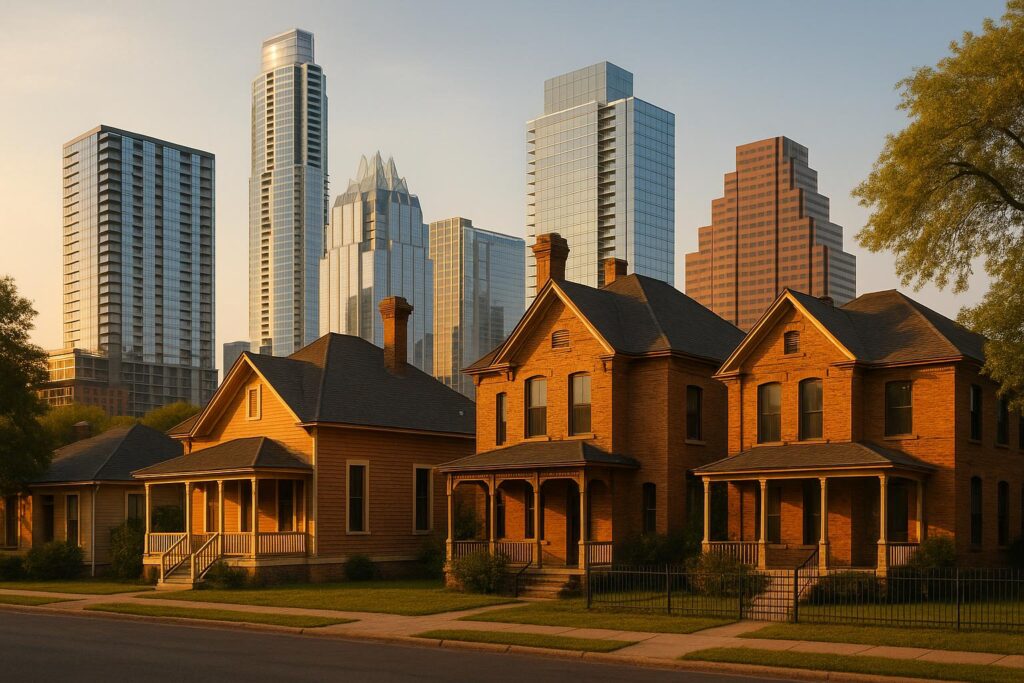Manufacturers are choosing Austin over other cities due to its tax-friendly policies and lower thresholds for investment and job creation. Here’s a quick summary of Austin’s key incentives compared to Dallas-Fort Worth, Phoenix, and Atlanta:
- Austin: Offers property tax abatements (up to 10 years) for investments of $1M+ and 25+ jobs, cash grants for large projects, and sales tax refunds for enterprise zones.
- Dallas-Fort Worth: Similar programs but with stricter criteria, including a $2M+ investment for property tax abatements and 100% machinery tax exemptions.
- Atlanta: Focuses on job creation with credits up to $5,000 per job and inventory tax exemptions.
- Phoenix: Limited details available; businesses must consult local officials for specifics.
Quick Comparison Table
| City | Key Incentives | Minimum Investment | Job Creation Requirement |
|---|---|---|---|
| Austin | Property tax abatements, TIRZ, cash grants | $1M | 25+ |
| Dallas-Fort Worth | Machinery tax exemption, stricter abatements | $2M | 50-100+ |
| Atlanta | Job tax credits, inventory tax exemptions | $5M (for some) | 10-50+ |
| Phoenix | Limited information, consult local officials | N/A | N/A |
Austin’s incentives are ideal for mid-sized manufacturers, while Dallas-Fort Worth and Atlanta cater more to larger-scale operations. Phoenix remains less defined. Keep reading for a detailed breakdown of each city’s programs.
Why Tesla Chose Austin, Texas for its Gigafactory?
1. Austin Tax Programs
Austin is known for its business-friendly policies, and the city offers five main tax incentives to attract and support manufacturers:
-
Property Tax Abatements (Chapter 312)
This program provides up to a 10-year reduction in property taxes for qualifying manufacturing facilities. To qualify, businesses must invest at least $1 million in capital and create a minimum of 25 new full-time jobs. The percentage of the abatement depends on the size of the investment and the number of jobs created. -
Tax Increment Reinvestment Zones (TIRZ)
TIRZ uses property tax revenue growth to fund public infrastructure improvements. This allows manufacturers to benefit from better infrastructure without having to pay upfront costs. Terms for TIRZ agreements typically last 20-30 years, with varying contribution rates. -
Texas Enterprise Fund
This program offers direct cash grants for large-scale projects that create jobs. To qualify, businesses must invest at least $10 million and create a minimum of 75 new jobs. Grant amounts range from $1,000 to $10,000 per job created. -
Texas Enterprise Zone Program
This program provides state sales and use tax refunds of up to $2,500 per job created. To qualify, businesses must either be located in designated enterprise zones or ensure that at least 35% of the new jobs benefit zone residents. Eligible projects can receive benefits for up to five years. -
Chapter 380 Economic Development Agreements
These agreements allow the city to offer grants based on negotiated performance metrics. Incentive payments are tied to meeting specific employment and investment targets, and they are typically structured as annual rebates over 5-10 years.
Next, we’ll take a look at how Dallas–Fort Worth’s tax incentives stack up against Austin’s offerings.
2. Dallas-Fort Worth Incentives
Dallas-Fort Worth offers its own set of tax breaks and exemptions aimed at attracting manufacturers, similar to Austin’s approach but with distinct requirements.
- Property Tax Abatement (Chapter 312): Provides up to a 10-year reduction in property taxes. To qualify, businesses must invest at least $2 million and create 50 new full-time jobs. This job creation requirement is stricter compared to Austin’s program.
- Manufacturing & Production Equipment Exemption: Offers a full exemption (100%) on machinery purchases. This applies to both new and expanded manufacturing facilities, with no minimum investment required – something not available in Austin.
- Tax Increment Reinvestment Zones (TIRZ): Allows for property tax reinvestment into site improvements over a 20-year period. Businesses need to invest at least $5 million to qualify, a higher threshold than Austin’s TIRZ program.
- Texas Enterprise Fund Grants: Provides cash grants ranging from $2,500 to $8,000 for each new job created. To qualify, companies must create at least 100 jobs and invest $15 million, which are higher requirements compared to Austin’s version of this program.
sbb-itb-4c99469
3. Phoenix Tax Benefits
Information about tax incentives for manufacturers in Phoenix is limited. To get the most up-to-date details, manufacturers should reach out directly to the City of Phoenix Economic Development Department. Next, we’ll take a closer look at the tax options available in Atlanta.
4. Atlanta Tax Options
Atlanta, a hub of growth in the Southeast, offers a range of tax incentives designed to support manufacturing and business expansion. These programs are tailored to encourage job creation and investment in the area:
- Job Tax Credit: Businesses in Metro Atlanta can receive a $3,500 credit per new job created, while those outside the metro area are eligible for $2,500 per job. This applies to projects that generate at least 10 jobs.
- Quality Jobs Tax Credit: Advanced-technology firms creating 50 or more jobs can qualify for credits of up to $5,000 per job.
- Investment Tax Credit: Companies making qualified capital investments of $5 million or more can earn a credit of 1% to 3%, which becomes refundable once the project is completed.
- Sales & Use Tax Exemption: A full exemption is available for manufacturing machinery and equipment purchases, with no minimum investment required.
- Freeport Exemption: Businesses can benefit from up to 100% exemption on inventory taxes for raw materials, goods-in-process, and finished goods.
- Property Tax Abatement: Depending on the size of the investment and number of jobs created, property taxes can be reduced by 50% to 100% for up to 10 years.
Benefits and Drawbacks
Austin’s tax incentives offer cost savings and infrastructure support but come with certain obligations and administrative hurdles. Here’s a closer look at the pros and cons across the four regions.
Benefits
- Property tax abatements of up to 10 years, cutting down capital expenses
- Direct grants and job credits to help reduce labor costs
- Infrastructure upgrades through TIRZ, improving site readiness
- Sales tax exemptions on manufacturing equipment
- Enterprise zone perks aimed at specific development projects
Drawbacks
- Potential long-term effects on local government revenue
- Strict qualification criteria, making eligibility challenging
- Complicated application processes with performance-based conditions
- Different program terms depending on the jurisdiction
- Limited room for adjustments in how incentives are structured
These factors play a key role in shaping regional competitiveness.
Key Findings
Examining the advantages and drawbacks across different regions highlights these insights:
- Austin: Known for its flexible property tax abatements, it has lower investment and job thresholds compared to DFW, making it a strong option for mid-sized manufacturers.
- DFW: Offers excellent equipment incentives through its full machinery exemption program, providing immediate relief for capital expenses.
- Atlanta: Stands out with top-tier job incentives, offering up to $5,000 per position for advanced technology companies creating 50 or more jobs.
- Phoenix: Lacks a defined program structure, so businesses need to work directly with economic development officials to get the latest details on incentives.
These points can help manufacturers decide on the best relocation option, depending on factors like their investment size, job creation goals, and equipment requirements.





